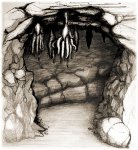Feedback Thread: Maps
- Thread starter Grützi
- Start date
The1True
My my my, we just loooove to hear ourselves don't we?
Looks like we've been on a similar wavelength!

I got lazy and let the toon renderer do the inking for me though...
I love what you did with the pen trace, if you're ever trying to get contour lines on your 3D map, try applying a lined texture-map side-on (along the x or y planes) to your map (although the results can be a bitch to clean up


I got lazy and let the toon renderer do the inking for me though...
I love what you did with the pen trace, if you're ever trying to get contour lines on your 3D map, try applying a lined texture-map side-on (along the x or y planes) to your map (although the results can be a bitch to clean up

squeen
8, 8, I forget what is for
Thanks y'all! Just for the sake of posterity, here's another version with a bit more contrast (probably prints B&W better) and an example of the inset.
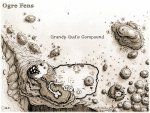

I'm going to leave it alone for now and get busy with the key, but at some point I'd like to retouch the pen & ink to clean up some mistakes. There'll be floor plans and sub-keys for Grandy's House (3 stories!), Tree Fort, and The Station, but that's about it.
I really like these little adventure "way points" as part of a longer journey. That seems to be my comfort zone. Running the mass-combat and palace intrigue stuff was stretching my abilities.
Hopefully we play it on this upcoming holiday. There's a missing scout being held prisoner in the pit (#19) with intelligence the party needs. That's the bait. When we last left things, the thief was in the complex---invisible of course! (They'd always invisible if they could pull it off...yeesh.)
EDIT: @T1T that is super cool and looks great! I'm not sure how to digest your tip...(I get texture map but how you are applying it in 3D I'd have to puzzle for a bit). I love the mech-bug on the rock pile, and those cliffs are so good they make me jealous. (Poop! I forgot my grid!)
Aah! True 3D!


I'm going to leave it alone for now and get busy with the key, but at some point I'd like to retouch the pen & ink to clean up some mistakes. There'll be floor plans and sub-keys for Grandy's House (3 stories!), Tree Fort, and The Station, but that's about it.
I really like these little adventure "way points" as part of a longer journey. That seems to be my comfort zone. Running the mass-combat and palace intrigue stuff was stretching my abilities.
Hopefully we play it on this upcoming holiday. There's a missing scout being held prisoner in the pit (#19) with intelligence the party needs. That's the bait. When we last left things, the thief was in the complex---invisible of course! (They'd always invisible if they could pull it off...yeesh.)
EDIT: @T1T that is super cool and looks great! I'm not sure how to digest your tip...(I get texture map but how you are applying it in 3D I'd have to puzzle for a bit). I love the mech-bug on the rock pile, and those cliffs are so good they make me jealous. (Poop! I forgot my grid!)
Aah! True 3D!
Last edited:
squeen
8, 8, I forget what is for
I struggle with this conceptually for art because WTF are those pen lines suppose to represent on a 3D ray-traced model?
I think the lines are perhaps crevices and shadows, but artist abuse them to create artificial boundaries. There are times when an edge should just vanish, and in the real world, there are times when contrast is just poor.
To get that effect with a 3D model you might(?) need more surface variation. Here's an example of a small patch of a ray-traced surface with fractual browian motion (fbm) noise on the height field.
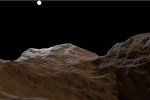
But see, no lines! A painter can get that with difference tone...but a pen-drawing has to make a decision on how to fake it.
One way is silhouette lines---but that frequently bugs me (on illustrations, not map) because those lines are cartoon-y and false.
Sometimes, with backlight, that outline is actuall done in white. Also, the thinkness of the black line can be varied to fake it less.
Am I making sense?
Sorry if this bores---it's just another pet peeve of mine....or more accurately a dilemma I fight every time I pick up a pencil.
Anyway, I think your illustration looks great, and is very clear and useful. That's what ultimately matters...it's easy to get caught up in aesthetics but that should come last, after utility---this is not Artpunk D&D.
I think the lines are perhaps crevices and shadows, but artist abuse them to create artificial boundaries. There are times when an edge should just vanish, and in the real world, there are times when contrast is just poor.
To get that effect with a 3D model you might(?) need more surface variation. Here's an example of a small patch of a ray-traced surface with fractual browian motion (fbm) noise on the height field.

But see, no lines! A painter can get that with difference tone...but a pen-drawing has to make a decision on how to fake it.
One way is silhouette lines---but that frequently bugs me (on illustrations, not map) because those lines are cartoon-y and false.
Sometimes, with backlight, that outline is actuall done in white. Also, the thinkness of the black line can be varied to fake it less.
Am I making sense?
Sorry if this bores---it's just another pet peeve of mine....or more accurately a dilemma I fight every time I pick up a pencil.
Anyway, I think your illustration looks great, and is very clear and useful. That's what ultimately matters...it's easy to get caught up in aesthetics but that should come last, after utility---this is not Artpunk D&D.
Last edited:
The1True
My my my, we just loooove to hear ourselves don't we?
Thanks, this is kind of what I was secretly worried about, lol.this is not Artpunk D&D.
If you're in the mood, try taking the above rendering into your photo manipulator of choice (I believe you use Gimp?) and try smooshing it through some of the available photo filters. There should probably be something that reduces the number of colours (and in the process creates cartoony 'planes'). That in combination with cranking up your Saturation to make your muddy naturalistic colours brighter (and once again, cartoony) might give you an appealing result. It will definitely take an hour or two of mucking around to get something you like and the best part is, what works for one rendering of red hills rarely seems to work for any of your other similar vignettes
squeen
8, 8, I forget what is for
Made the floor plan to the Cabin in my very antique 2D CAD program. Using CAD, with it's ability to: draw with real dimensions (feet not pixels), trim/extend lines and snap to end-points/mid-point/intersections as well as copy/mirror/array objects...well, I've really missed it since my AutoCAD (R12) days. That's what motivated me to write my own app and recreate that utility in it's elegant simplicity. It's really painful trying to use your own programs at first---so much is either missing or broken. You end up moving at something like 10% speed. But, if you keep at it, you get enough of the foundation in place things start to eventually take off. I think I turned that corner about a month ago with this one...this was the first time just using it as oppose to debugging it. Somewhere further down the road, because you own the code, you can start making it do things nothing else gets quite right for your tastes. It becomes a tool that's almost an extension of your hands. It's neat if you can ever get there...but ultimately time is your enemy.
That said, I will always feel the finished maps made this way are a bit lacking in character. They look like an 1990's architect's blueprint. I'm thinking I will print it out lightly and then use it as a guide to ink it by hand and add some texture and minimal shading....some day!
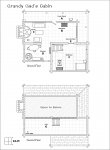
College is out, so we play test it tomorrow!
That said, I will always feel the finished maps made this way are a bit lacking in character. They look like an 1990's architect's blueprint. I'm thinking I will print it out lightly and then use it as a guide to ink it by hand and add some texture and minimal shading....some day!

College is out, so we play test it tomorrow!
Last edited:
squeen
8, 8, I forget what is for
I made a map of the Air Station above the Ogre Compound...but I think it took a hard turn in the direction of gonzo.

So much for entering this locale in Prince's Contest.
I should probably mention, that we are being locally inundated by the 17-year cicadas in my backyard---hence the bug in the upper left.

So much for entering this locale in Prince's Contest.
I should probably mention, that we are being locally inundated by the 17-year cicadas in my backyard---hence the bug in the upper left.
Last edited:
The1True
My my my, we just loooove to hear ourselves don't we?
Why is this gonzo? Are the Tasloi bee-riders in Dwellers of the Forbidden City gonzo? If Squeen is concerned about gonzo gatekeeping I worry for us all.I think it took a hard turn in the direction of gonzo.
THIS is gonzo:
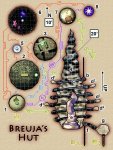
I grew up in a part of the States that called those things 'locusts' (erroneously I guess?). I miss that sound of summer.
squeen
8, 8, I forget what is for
squeen
8, 8, I forget what is for
I've been slow to respond to this, because it's a tough question.@squeen, I understood Campaign Cartographer is a CAD program, is there a reason you don't use it?
The simple answer is CC3+ is a MS Windows application only, and I haven't run or used Windows since 1999.
I had rejected it outright on that basis initially, but since you asked the question I went to their site and looked at it more closely. Here are my observations:
- It definitely has that late-1990's MS Windows aesthetic, and it's uber-simplistic and bitmap-crude interface reminds me of AutoCAD R13 (1999?). In that sense, it appeals to my notion of stripped down tools.
- It doesn't look like they made any updates to it for over 12 years. (2008 was the tutorial I watched from their site)
- It's very close to what I've started building, I think its author and I are coming mentally from that same early GUI desktop-CAD background.
- It's low-res and non-hardware accelerated graphics---I've seen this as problem with some of their rendered output in maps Malrex made. I think their software needs an overhaul that switches it to hi-res off-screen rendering (e.g. EGL) at print resolution. This is similar to what Apple did for their "retina" displays---off-screen resolution is 2x of their laptop display. CC3+ need off-screen fonts, icons, line-segmentation, etc. at 300-600dpi to make better maps for publication. All their low-res iconography prints very blocky and looks poor at 4K resolution.
- It seems to be missing extend/trim/fillet functionality. That's huge in my book.
- I do like its fractal lines feature. I'm gonna steal that! (but at higher resolution/harmonics)
- I like it's use of "sheets" to give certain "pixel-effects" for rendering. I had planned something similar (without sheets, just the layers).
- I'd also like to mix-in a limited amount of 3D and "paint/GIMP" functionality too.
- it's the same DIY spirit that makes me also want to produce my own D&D content --- I like to build stuff! I see CC3+ and think: "There nothing to that! I bet I could make it!". That a big part of those early TSR modules too. Think about it.
- wanting a very specific left-hand keyboard (command-line/hotkey) + right-hand mouse synergy that that AutoCAD R11-13 gave the user before it abandoned it for a more GUI-button interface. It was powerful, and it's ingrained in my muscle memory. I miss it!
- I really like open source. We have GIMP today because a Linux guy got pissed that Photoshop was just for Windows and co$t too much.
- I want, what I want. i.e.
- I don't love the a lot of CC3+ visual aesthetic.
- I don't want to create cookie-cutter maps that look like everyone else's
- I want the freedom to try and do "more" and "different". That's the joy of a hobby.
- I can use my general purpose 2D CAD program for lots of other things than just maps.
Last edited:
EOTB
So ... slow work day? Every day?
Not that you need to use CC3, but it's continually updated. They released a major update a few years ago, which freshened up the interface a little without changing it (buttons in same place, etc.) What it didn't change was how you use the program, so the tutorials from 2008 still work, and is why they're still up.I've been slow to respond to this, because it's a tough question.
It also has snip, extend, etc. At least - if I understand what you mean, not knowing your program.
But like I said, not to imply you should use it. You look like you're doing fine with what you like.
The1True
My my my, we just loooove to hear ourselves don't we?
I'm interested to see how your fractal noise looks when you add it to your linework. I've been using a fast and dirty ripple deformation to make my lines a little wonky. I'm not super happy with it (it's unidirectional). I needed dirt and debris on a map I did a while ago and ended up creating some noise and using it to cut into the lines a bit and add to the lines a bit (for a sort of swiss cheese effect on the edges of the linework), but it's generally more work than it's worth.
Yeah, Breuja's hut is insanity. I havn't gotten any love on my last two installments of the Bulls Run, so I'm holding out til next week with the Mutant Camp and Witch's Hut and then I'm calling it quits for a while. My obsession with that moribund project is unhealthy lol
Yeah, Breuja's hut is insanity. I havn't gotten any love on my last two installments of the Bulls Run, so I'm holding out til next week with the Mutant Camp and Witch's Hut and then I'm calling it quits for a while. My obsession with that moribund project is unhealthy lol
squeen
8, 8, I forget what is for
grodog
*eyeroll*
I think that complex maps do encourage more exploration---when we intrigue the players, their characters follow!Most importantly, does a topologically-complex map invite exploration?
That makes sense. I group basic encounters into four main types (with full explanations at https://grodog.blogspot.com/2017/05/dungeon-strangitude-variations-on.html if you're curious):So the question is whether the topological complexity of the environment inspires the PCs, which turns in part on the DM's ability to explain it. And I suspect it depends, it isn't as simple as topological complexity, it may depend on what kind of complexity.
Since players spend much of their time interacting with #1 and #2, while seeking #3 and #4, the only ways to provide variety in literally-empty rooms, chambers, and connecting corridors sometimes seasoned with dungeon dressing is via the dungeon map design itself. That, in part, helps to define _why_ corridors have many common width options (5', 10', 20', 30'+), why intra-level stairwells are important, why moving walls, streams and wells, airshafts, trapdoors up/down, stairwell landings, etc., etc. are important to keeping the exploration interesting, because most of the time the level's design is what the encounter is (i.e., nothing or dungeon dressing). Etc.
- Nothing: literally nothing to see here—search for secret doors and move along; I try to insure that that a number of seemingly-empty rooms are, in fact, empty, to help dungeon dressing stand out further
- Dungeon dressing: spot color to maintain the game’s flow, provide distraction, and avoid player boredom; some dressing will be simple spot color, while some will be “special” dungeon dressing---dressing with inspirational potential that could build into a something of significance, and perhaps even a true encounter, depending upon the players’ actions in response (i.e., when I'm winging it); in general, dungeon dressing should also highlight the unique aspects of a level in the small, details that make A1 differ from A4 (I dislike the term “special” so if you think of a better adjective, please let me know!)
- Encounters: the usual mix of monsters, treasures, traps, hazards, riddles, puzzles, tricks, enigmas, and other dungeon features that wreak havoc upon PCs
- Centerpiece encounters: the unique and distinctive encounters that resonate with players across the years of a campaign, like the Black Reservoir and Great Stone Face of Castle Greyhawk, and the Unopenable Doors and Terrible Iron Golem of Maure Castle
Agreed: I'm not particularly fond of intentionally trying to confuse mappers. I just happen to like building complex maps, which may be confusing (although I do try to describe them clearly).I do know that I don't like maps that are designed to confound mapping.
I have a blog post (or perhaps more properly a TTS article, I suppose) I've been noodling on for awhile about interstitial encounters, which I think your way-points may also sort of point toward. More soon!I really like these little adventure "way points" as part of a longer journey.
Allan.
squeen
8, 8, I forget what is for
Great stuff @grodog . I think you see it very clearly. This reminds me a bit of your articles in the Twisting Stairs. (quotidian!) I look forward to your blog post.
I will admit that I personally don't create a with such a God's Eye View towards the setting. (fraction of empty rooms, fraction of encounters, etc.) What you are doing is considering the player experience which is probably the "good DM" way to do it. What I do, (the bad DM method?) is imagine the space, think about the entities in it or it's original intended purpose, and just kept pulling on that logical thread. It's really nothing more than saying, "This is house. It needs a kitchen, a bedroom, a bathroom, etc.", or similarly the verisimilitude (Gygaxian Naturalism?) that prevents a bizarre fun-house type of dungeon with a red dragon closeted in a room next to a bunch of orcs.
My method all hinges on some sort of brainstorm for the initial concept that is hopefully not too dry or overdone (note theses are both cooking metaphors, I haven't had breakfast yet)---whatever that might be. Then there are a bunch of meat-and-potatoes (another food analogy!) elements that are needed to support the core conceit. I know, I'm not really saying much...but it's just a wind-up for the next point.
In order for that basic infrastructure, built around a single central idea, not to be too predictable, I then (like some over-sized bunny), I start dropping in Easter Eggs. Things that don't belong. So that even I (and hopefully later the players) say, "Hey! I didn't expect to see you here!".
(To which you all should have chimed, "Nobody expects the Spanish Inquisition!")
Maybe this is my personal concept of gonzo, i.e. not a wholly bizarre and faux-medieval breaking location, but a small pocket of chaos tucked in a carefully built up backdrop of status-quo logic. Duck-duck-duck-duck-goose!
Guy Fullerton did this recently in what he is preparing for the OSRIC 15th anniversary product. A wacky Many Gates of Gann style laboratory in a hidden layer behind the more classical D&D foes i.e. an Easter Egg!
It only solidified in my mind recently, as to what I had been doing all along unconsciously. Giving it a label now opens it up to radical abuse and overuse!
One more mental conceit: I think complex topography can be, in a sense, a non-linear dungeon stand-in. So long as you are crawling up/over/in-between and around---now inside, now outside, etc...it results in the same sense of choice for the players (even outdoors).
I will admit that I personally don't create a with such a God's Eye View towards the setting. (fraction of empty rooms, fraction of encounters, etc.) What you are doing is considering the player experience which is probably the "good DM" way to do it. What I do, (the bad DM method?) is imagine the space, think about the entities in it or it's original intended purpose, and just kept pulling on that logical thread. It's really nothing more than saying, "This is house. It needs a kitchen, a bedroom, a bathroom, etc.", or similarly the verisimilitude (Gygaxian Naturalism?) that prevents a bizarre fun-house type of dungeon with a red dragon closeted in a room next to a bunch of orcs.
My method all hinges on some sort of brainstorm for the initial concept that is hopefully not too dry or overdone (note theses are both cooking metaphors, I haven't had breakfast yet)---whatever that might be. Then there are a bunch of meat-and-potatoes (another food analogy!) elements that are needed to support the core conceit. I know, I'm not really saying much...but it's just a wind-up for the next point.
In order for that basic infrastructure, built around a single central idea, not to be too predictable, I then (like some over-sized bunny), I start dropping in Easter Eggs. Things that don't belong. So that even I (and hopefully later the players) say, "Hey! I didn't expect to see you here!".
(To which you all should have chimed, "Nobody expects the Spanish Inquisition!")
Maybe this is my personal concept of gonzo, i.e. not a wholly bizarre and faux-medieval breaking location, but a small pocket of chaos tucked in a carefully built up backdrop of status-quo logic. Duck-duck-duck-duck-goose!
Guy Fullerton did this recently in what he is preparing for the OSRIC 15th anniversary product. A wacky Many Gates of Gann style laboratory in a hidden layer behind the more classical D&D foes i.e. an Easter Egg!
It only solidified in my mind recently, as to what I had been doing all along unconsciously. Giving it a label now opens it up to radical abuse and overuse!
One more mental conceit: I think complex topography can be, in a sense, a non-linear dungeon stand-in. So long as you are crawling up/over/in-between and around---now inside, now outside, etc...it results in the same sense of choice for the players (even outdoors).
Last edited:
squeen
8, 8, I forget what is for
BTW, I love these examples! Great prose in the blog-article.Centerpiece encounters: the unique and distinctive encounters that resonate with players across the years of a campaign, like the Black Reservoir and Great Stone Face of Castle Greyhawk, and the Unopenable Doors and Terrible Iron Golem of Maure Castle
[...]
Through taunting riddles, strange portals, the sheer busyness of its elaborate frescoes and bas-reliefs—and hideous death traps, of course—S1 Tomb of Horrors builds an overwhelming feeling of dread in PCs (and players, perhaps!), and of ancient, undisturbed secrets best left unsought.
[...]
Some mysteries of dungeon dressing are not meant to be solved immediately, if ever—otherwise they’re not mysteries, right?

